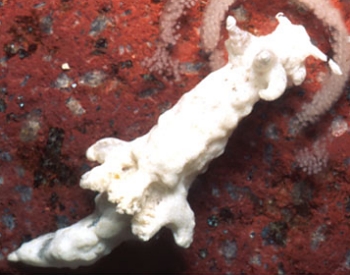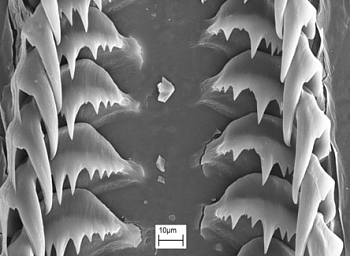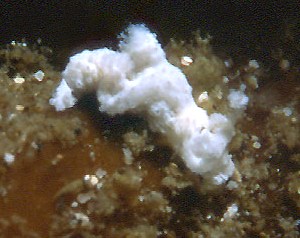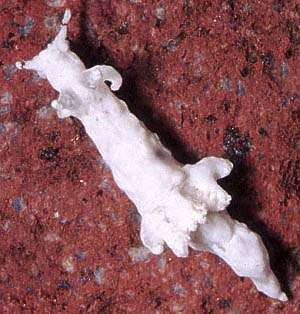

Trapania armilla
Gosliner & Fahey, 2008
Order: NUDIBRANCHIA
Suborder: DORIDINA
Superfamily: ANADORIDOIDEA
Family: Goniodorididae
DISTRIBUTION
Known only from Bali, Indonesia.
PHOTO
Upper: CASIZ 172860, Bali, Indonesia, 7 mm. Photo: M. Miller. Lower: CASIZ 172860. Radular morphology. Scale =10 µm.[From Gosliner & Fahey 2008: Fig. 24C].
The dorsum is lumpy, rather than smooth. The whole of the body is completely white, except for a thin dark brown ring about two-thirds of the way along the oral tentacles. From the photo it appears that in some of the 'pits' of the lumpy body, there may be translucent clear patches, but that is hard to determine.
One feature I am not sure about is Gosliner & Fahey's description of "two bifurcated extra-branchial appendages". A bifurcated extra-branchial appendage would be most unusual. I have only the photo to refer to and it appears from that, that there is a single extra-branchial appendage on each side which arises from the base of the lowest gill. Perhaps there is a lower branch of the extra-branchial appendage on each side, hidden from our view in the photo?
The animal is reported to grow to at least 7 mm in length.
-
Gosliner, T.M. & Fahey, S.H. (2008) Systematics of Trapania (Mollusca: Nudibranchia: Goniodorididae) with descriptions of 16 new species Systematics and Biodiversity, 6 (1): 53-98
Rudman, W.B., 2008 (March 10) Trapania armilla Gosliner & Fahey, 2008. [In] Sea Slug Forum. Australian Museum, Sydney. Available from http://www.seaslugforum.net/find/traparmi
Related messages
Trapania armilla? from Lembeh
March 14, 2008
From: Massimo Boyer

Dear Bill,
This photo was taken in Lembeh Strait, Sulawesi, about 10 m depth during the day. The animal was about 2 cm long. It could be a Trapania sp.?
Sorry about the quality of the photo, it is not good at all, but I was at the end if my film and this is the only picture that I could take ...
Regards,
Massimo Boyer
massimo@edge-of-reef.net
Boyer, M., 2008 (Mar 14) Trapania armilla? from Lembeh. [Message in] Sea Slug Forum. Australian Museum, Sydney. Available from http://www.seaslugforum.net/find/8667Dear Massimo,
This photo has been waiting in the backlog for a long time mainly because I couldn't really decide what it is. However the recent description of a white 'lumpy' Trapania - Trapania armilla - make me think that your animal could be that species. Unfortunately I can't see the oral tentacles clearly and in the description of this species a dark ring on each tentacle is the only colour pattern.
Best wishes
Bill Rudman
Trapania aureopunctata? from Bali
November 16, 1998
From: Michael Miller

Note added 12 March 2008: This species has been named Trapania armilla .
Bill,
As a result of a recent posting on your site, I suspect the attached Trapania pic is probably that of Trapania aureopunctata. If so, it might represent a significant range extension based on the distribution information posted as the animal was photographed / collected at Tulamben, Bali, Indonesia during a recent trip. Please feel free to post the image on your site with any comments.
Mike
Happy slugging,
Michael Miller
mdmiller@cts.com
Miller, M.D., 1998 (Nov 16) Trapania aureopunctata? from Bali. [Message in] Sea Slug Forum. Australian Museum, Sydney. Available from http://www.seaslugforum.net/find/310Dear Mike,
If it is Trapania aureopunctata then you are correct in saying there would be a significant range extension.
My only record of Trapania aureopunctata is from Sydney, New South Wales. Normally I wouldn't have named the animal as a new species on a single specimen but in the context of reviewing all the known species, it was clearly distinct.
What I didn't know was whether it was a temperate species endemic to southern Australia, or a tropical species visiting Sydney with the help of some warm currents from the tropical north.
The one difference I can notice in your animal is the dark band on the oral tentacles. Perhaps my specimen was too small to show the detail. One character which would help is the radula. If you have the specimen and would be willing to let me cut it up I could have a look at the tooth morphology.
Best wishes,
Bill Rudman.
